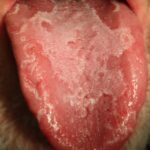
Geographic tongue, also known as benign migratory glossitis, is characterised by smooth areas on the top and sides of the tongue due to an absence of filiform papillae. As geographic tongue is commonly diagnosed with oral clinical examination recognising the tongue lesion is an important part of professional practice. Understanding the frequency of this condition in the population is helpful in establishing the diagnosis and providing information to patients.
The aim of this systematic review and meta-analysis was to determine the global prevalence of geographic tongue in patients >18 years.
Methods
This review followed PRISMA guidelines, and the protocol was registered in PROSPERO database. Searches were conducted in online databases of Embase, PubMed/Medline, LILACS, Scopus, and Web of Science. In addition, the grey literature sources Google, Scholar, ProQuest Dissertation and Theses, and OpenGrey were searched. An inclusion criteria was applied to ensure all studies within this review were on adult patients (>18 year old) with no co-morbidities. No restriction criteria regarding language and publication time were applied. Two investigators independently screened potentially relevant studies and extracted data. The methodological quality of each study was assessed using the Joanna Briggs Institute (JBI) Critical Appraisal Checklist for Studies Reporting Prevalence Data (Critical Appraisal Tools | JBI). Prevalence was divided in to two types – point prevalence (the number of cases in a specific point in time) and period prevalence (the number of cases in a specific period). Meta-analyses were carried out separately for point and period prevalence.
Results
- 11 analytical cross-sectional studies, published between 1990 and 2020, were included for quantitative analysis.
- Studies were conducted in Brazil, Cambodia, China, Finland, Germany, Hungary, Iran, Israel, Nigeria, Sweden, and Turkey.
- Two studies were rated as low methodology quality, five were considered moderate quality, and four were considered high quality.
- Sample size of studies ranged from 496 to 6932.
- Age range ranged between 18 to 106 years old.
- All studies diagnosed geographic tongue using oral examination.
- The period prevalence meta-analysis found the prevalence rate to be 3% (95%CI; 0.4% to 5.5%)
- The point prevalence meta-analysis found the prevalence rate to be 3% (95%CI; -0.2% to 5.5’%)
- The geographic tongue prevalence ranged from 0.2%-12.8% and is shown in the table below.
| Country | Sample Size | Number of cases | Prevalence rate |
| Brazil | 1,006 | 27 | 2.7% |
| Cambodia | 1,634 | 7 | 0.43% |
| China | 537 | 1 | 0.2% |
| Finland | 1,961 | 18 | 0.9% |
| Germany | 2,022 | 45 | 2.24% |
| Hungary | 6,932 | 190 | 2.74% |
| Iran | 1,581 | 41 | 2.6% |
| Israel | 2,464 | 315 | 12.8% |
| Nigeria | 690 | 2 | 0.29% |
| Sweden | 920 | 50 | 5.6% |
| Turkey | 496 | 7 | 1.41% |
Conclusions
The proportion of geographic tongue in adults varied widely around the world. However, the results demonstrated that approximately one in 30 adults has geographic tongue.
Comments
The researchers carried out an extensive literature search with no restriction on date of publication or language which allowed them to review a wide range of potentially relevant studies. This review provides a helpful estimate on the worldwide prevalence of geographic tongue however it should be considered that not all countries are represented. To add to this, the data collected in some studies may only be representative of a particular area or region and not the whole country. As there is no protocol for the clinical evaluation of geographic tongue it should be considered that studies may have used different parameters for the diagnosis of this condition which may affect the findings within this review. Another limitation to consider when interpreting the data is that individuals with geographic tongue can have periods of remission meaning this condition may be under reported in a cross-sectional study with no follow up. Despite the limitations, this systematic review does provide a helpful estimate the global prevalence of geographic tongue. Geographic tongue is a relatively common condition that can present to general dental practice, so this review is helpful in informing both dentists and patients on the prevalence of this condition.
Oral Health Foundation website is a helpful resource that provides jargon-free basic information about geographic tongue and may be a helpful resource for dentists to provide simple explanations to patients or for patients to access directly. Available from: Geographic tongue – Oral Health Foundation (dentalhealth.org)
Links
Primary paper
Pereira RDPL, de Oliveira JMD, Pauletto P, Munhoz EA, Silva Guerra EN, Massignan C, De Luca Canto G. Worldwide prevalence of geographic tongue in adults: A systematic review and meta-analysis. Oral Dis. 2022 Oct 8. doi: 10.1111/odi.14397. Epub ahead of print. PMID: 36208129.
Picture credits
Bin im Garten, CC BY-SA 3.0, via Wikimedia Commons
